Rust Family Foundation: Archaeology Grants Program
Death Comes to Oplontis:
Recording and Analyzing Skeletons of Victims of Mount Vesuvius (79 AD)
Principal Investigator: Dr. Kristina Killgrove
Assistant Professor, Department of Anthropology, University of West Florida
Numerous urban centers in the Bay of Naples, Italy, were completely destroyed by the eruption of Mount Vesuvius in 79 AD, including the cities of Pompeii and Herculaneum, and the villas of Stabiae and Oplontis (Fig. 1). Although Pompeii has been excavated and analyzed
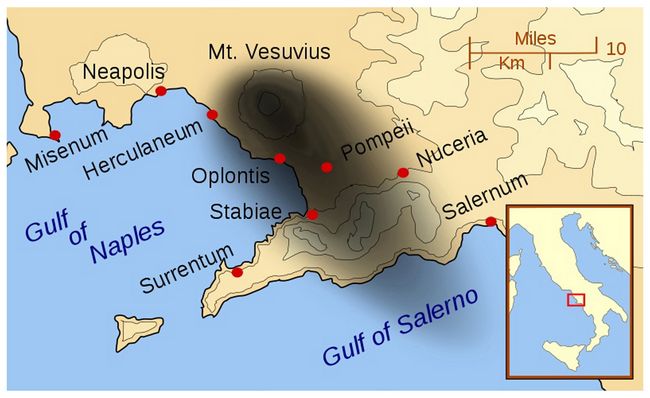 for centuries, professional archaeological work
did not begin at Oplontis until 1964. Progress was spotty over the
years, but new work ongoing by the Oplontis Project is seeking to
change this by bringing together a team of specialists to integrate as much data as possible from this massive villa site (Clarke 2016).
for centuries, professional archaeological work
did not begin at Oplontis until 1964. Progress was spotty over the
years, but new work ongoing by the Oplontis Project is seeking to
change this by bringing together a team of specialists to integrate as much data as possible from this massive villa site (Clarke 2016).Fig.1: Bay of Naples showing location of Oplontis, and impact area of Vesuvius eruption in AD 79.
Villa A of Oplontis may have been that of Poppaea, the second wife of Emperor Nero, while the commercial structure called Oplontis B was the location of a wine business (Thomas 2016). At the time of the eruption of Vesuvius, Villa A was unoccupied. However, more than 50 skeletons were found in Room 10 of Oplontis B (Fig. 2), likely representing the business owner, L. Crassus Tertius based on a wine seal, and his workers and slaves. Half of the skeletons were excavated and removed in the 1980s, and the other half were partially excavated and left in situ in the 1990s.
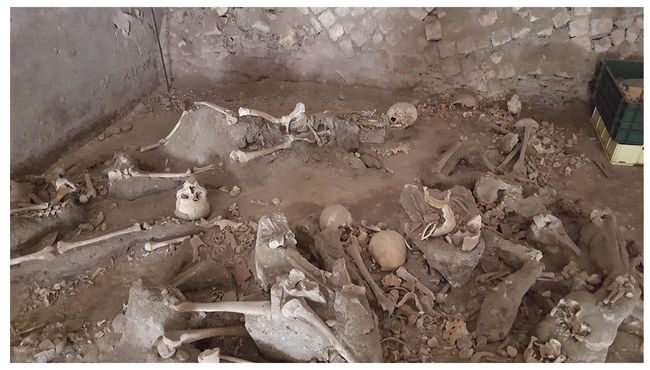 .
.Fig.2: Photograph of Room 10 of Oplontis B, Prior to Excavation.
The in situ skeletons of Oplontis are significant for a study of cause of death. While these people clearly perished due to the volcanic eruption, research on Pompeii and Herculaneum has yielded different interpretations of the mechanism of death (Mastrolorenzo et al. 2001, 2010; Luongo et al. 2003). One early theory is that people suffocated slowly on gas mixed with ash, which created a kind of cement in their lungs. Another theory holds that the body postures of the casts from Pompeii reveal death by thermal shock, in which extreme heat rapidly burns the skin and causes cardiac arrest.
Previous Research at the site
Prior to 2017, no bioarchaeological or osteological analysis of the skeletons from Room 10 of Oplontis B had ever been published. As these skeletons represent a catastrophic mortality sample, they are important for understanding the overall health status of the Romans in the 1st century AD. Further, since Oplontis B includes both a business area and a domestic area, it is assumed that the skeletons may represent one or more extended families, along with individual workers and slaves. This project was therefore undertaken in order to learn more about health, disease, cause of death, and familial relationships.
2017 Funded Research Project (RFF-2017-26)
Goals:
This project, undertaken from July 10 through August 16, 2017, focused on the excavation of a small sample of skeletons from the site of Oplontis, Italy. Destroyed by the eruption of Mt. Vesuvius on August 24, 79 AD, Oplontis was preserved intact for nearly two millennia.
There were three major goals for this project. First, the PI and her team sought to digitally preserve this cultural heritage through 3D scanning and photomodeling prior to excavation. As the Oplontis remains had not been conserved, and as access to the remains is extremely limited, creating 3D models using scanning and photogrammetry technology was therefore important for both protecting this cultural heritage and for opening up access to the skeletons so that their mechanism of death can be fully studied.
The second goal was to excavate the remaining skeletons and associated personal items that had been pedestaled for 25 years, in order to yield new stratigraphic information about the arrangement of the bodies that can contribute to an understanding of the cause of death. Work along these lines has already been done at Pompeii (Duday 2009; Van Andringa et al. 2013).
The PI’s third goal was to share the data produced in this project with other researchers and with the general public, primarily through a website showcasing the digital models and through news media coverage of the project and its findings.
Methodology:
Before any excavation occurred, digital preservation was accomplished using both photogrammetry and 3D scanning. A standard protocol was used for photogrammetry, adapted from the Gabii Project (2013), an archaeological excavation outside of Rome, Italy. High-resolution photos were taken using a DSLR camera.
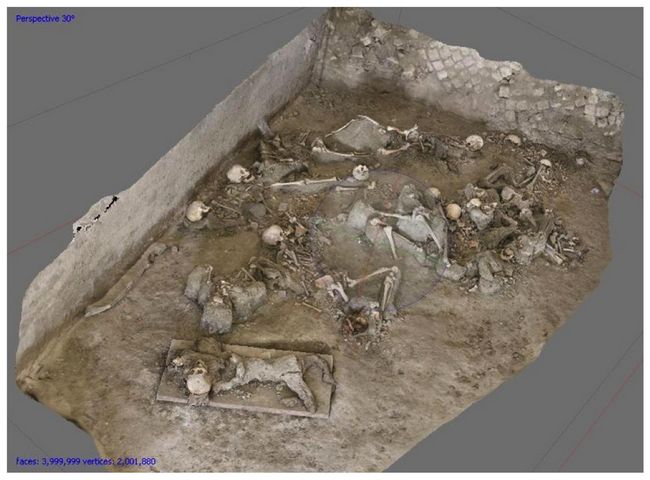
.
Fig.3: Photomodel of Room 10 of Oplontis B
The photos were then built into a georeferenced 3D model using AgiSoft Photoscan Pro. Photomodels were created prior to excavation (Fig. 3), as well as during excavation at various stratigraphic levels and of forensically important skeletons. One photomodel is currently available on the PI’s project website, FacesofOplontis.com.
Scanning of eight skulls was accomplished using the PI’s handheld Sense scanner, and panel scans of the in situ skeletons were taken using a Structure scanner attached to an iPad. All models were saved to portable hard drives in the field, and then manipulated back in the US in Autodesk Meshmixer to create watertight .STL files. These scans are also available at FacesofOplontis.com.
Excavation of the in situ pedestaled remains was accomplished using hand tools (trowels, brushes, and bamboo as necessary) following definition of a polygon of interest. Each polygon was georeferenced in the photogrammetric model, and bones, soil, and artifacts from that polygonal area were bagged and labeled together. As time on site was short in 2017, excavation aimed to preserve as much archaeological context as possible, with further analysis of the excavated material, including screening and flotation of the dirt, planned for summer 2018.
Results:
The results of this first phase of research at Oplontis fall into three categories: digital modeling, excavation, and osteological analysis.
Digital modeling:
As noted, digital models were created of the skeletons in Room 10 before and during archaeological excavation of the pedestaled remains. These models were created using photogrammetry in AgiSoft Photoscan Pro. The pre-excavation model has been posted online at FacesofOplontis.com, but the models created during excavation have not yet been fully processed. The PI and her team are working through these models in an attempt to better understand cause of death (or the precise way in which people died at Oplontis) and taphonomic changes over the past two millennia.
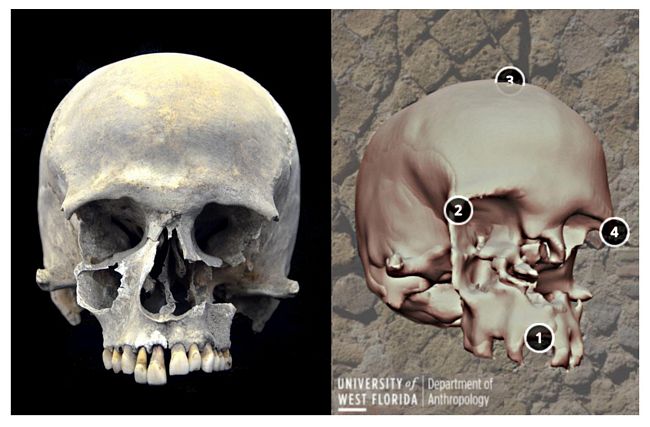 Using
the models, we are continuing our attempt to understand whether all
individuals in Room 10 perished at once, or rather in different phases
during the volcanic eruption. 3D scans were also taken of eight
complete crania, in part to better visualize antemortem injuries (such
as blunt force injuries from falling objects) versus taphonomic damage.
Using
the models, we are continuing our attempt to understand whether all
individuals in Room 10 perished at once, or rather in different phases
during the volcanic eruption. 3D scans were also taken of eight
complete crania, in part to better visualize antemortem injuries (such
as blunt force injuries from falling objects) versus taphonomic damage.
Fig.4: Skull from Skeleton M, Oplontis B
To date, no clear antemortem injuries have been discovered, although several small, healed blunt force injuries have been found to skulls (Fig. 4). Currently, the PI has partnered with a forensic artist in an effort to complete one or two facial reconstructions from the 3D scans. These reconstructions are still in process; results of that will be shared as soon as practical at FacesofOplontis.com.
Excavation:
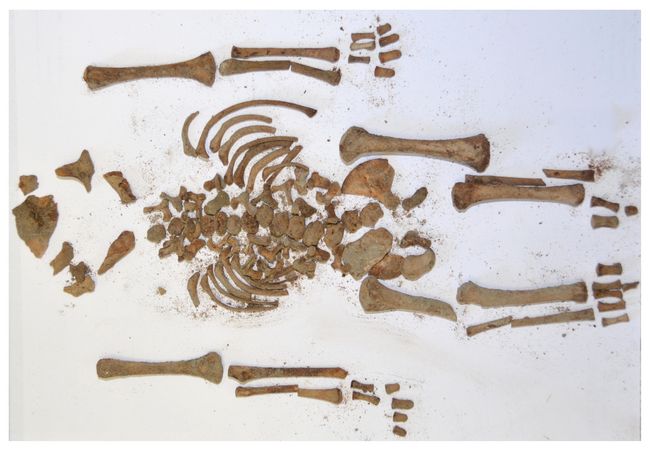
Excavation of the in situ remains was accomplished following photomodeling and appropriate documentation. Results of the excavation reveal that there were more individuals that initially assumed. At least two infants were found underneath adult remains, and at least one fetus was discovered in the abdominal cavity of a middle adult female (Fig. 5).
Fig.5: Fetus (c. 36 weeks’ gestation) found in abdominal cavity of Skeleton M at Oplontis B
In terms of artifacts, most had already been discovered in previous excavations. As the PI and her team took down the pedestals, however, additional Roman coins and broken oil lamps were found. Organic remains were also preserved in the form of wicker mats and impressions of matting/fabric and of stone fruit.
Osteology:
Osteological analysis was one of the primary drivers of this project, as more than 50 individuals appear to have huddled into Room 10 of Oplontis B and died more or less at the same time. While the team attempted to create a solid minimum number of individuals (MNI) estimate, this was complicated by the somewhat commingled nature of the previously excavated skeletons as well as the state of the in situ skeletons. We can confidently say that there were at least 50 individuals, but the number is likely between 50-60.
The preliminary demographic chart (Fig. 6) reveals the interesting nature of this catastrophic mortality sample; whereas cemetery samples tend to show high infant
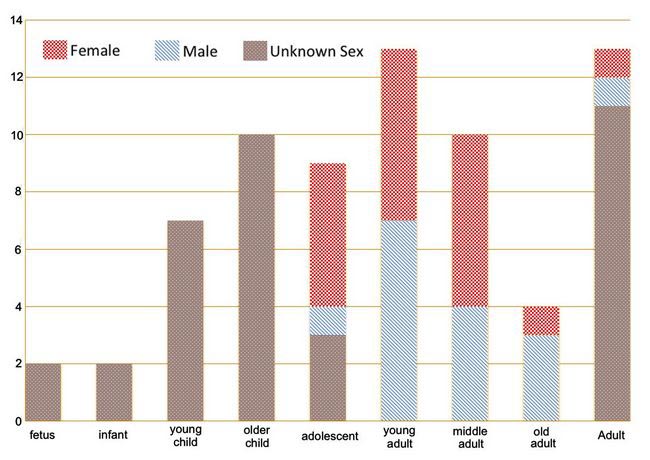 mortality, this sample more clearly represents a living population of
what was likely one or more extended families. Further work will be
carried out in Summer 2018 to better estimate the MNI and to
reconstruct individuals, with help from old Italian excavation reports,
old diagrams, and photogrammetric models and photographs taken in 2017.
mortality, this sample more clearly represents a living population of
what was likely one or more extended families. Further work will be
carried out in Summer 2018 to better estimate the MNI and to
reconstruct individuals, with help from old Italian excavation reports,
old diagrams, and photogrammetric models and photographs taken in 2017.
.
Fig.6: Preliminary Demographic Chart of Skeletons from Oplontis B .
Beyond MNI, the sample is intriguing for its relative lack of pathological lesions. Commonly assessed in bioarchaeology are porotic hyperostosis as an indication of anemia and periostitis as an indication of injury or infection. There were surprisingly few instances of these pathological skeletal lesions. Dental pathology frequencies such as carious lesions and calculus were high, but not higher than expected given the PI’s previous work on Imperial era cemetery samples from Rome.
Somewhat supporting the hypothesis that Oplontis B represents one or more extended families are cranial and dental nonmetric trait frequencies. While statistics have not yet been run on these data, the high frequency of persistence of metopic suture and of shovel-shaped incisors, which are uncommon elsewhere in the Italian peninsula in this time period, suggest biological relationships that will be further tested through DNA analysis.
Conclusions and Future Work:
Archaeological excavation in the summer of 2017 revealed two previously unknown infants and one previously unknown fetus, which brings the total number of pregnant women at Oplontis to at least two. Excavation also revealed a few additional artifacts and a surprising stratigraphy that may allow us to reconstruct the hours before and after the deaths of these individuals. Osteological analysis of the skeletons and teeth suggest that these people were fairly healthy when they met their untimely demise. This study is the first professional assessment of this important population of people who perished in 79 AD along with their compatriots from Pompeii, Herculaneum, and Stabiae.
In addition to the extra data collection that needs to be accomplished on site in summer 2018, the PI and her team have plans to subject samples that we collected from teeth and bones to biochemical analysis over the coming year or two. Given the presence of genetically linked traits, we assume that many of the people at Oplontis were biologically related. However, the make-up of the lower-class Roman family is currently poorly understood from historical records, so an ancient DNA study will add new information along these lines.
Plans have also been made to study the antemortem diets of the people of Oplontis through carbon and nitrogen isotope analysis, and to investigate their migration patterns through strontium and oxygen isotope analysis. While on site, we took samples from soil in the pelvis of eight individuals; these samples were sent to the University of Cambridge for analysis of intestinal parasites. Through this future work, the PI and her team hope to provide a well-rounded assessment of health and relatedness of the Oplontis individuals through archaeological, osteological, and biochemical analysis.
Plans for publication of the archaeological and osteological data are being devised, and will most likely take the form of articles in peer-reviewed journals.
References:
Clarke, J. 2016. “From the archives to the field: revisiting Villa A and Oplontis B,” in Gazda & Clarke, eds., pp. 57-65.
Duday, H. 2009. The Archaeology of the Dead: Lessons in Archaeothanatology. Oxbow.
Gabii Project. 2013. “Gabii Goes Digital. 21st c. Data, 21st c. Publications. Rich Digital Data and 3D Model Production.” Last retrieved from http://gabiiserver.adsroot.itcs.umich.edu/gabiigoesdigital/ on 6 Feb 2018.
Gazda, E. and J. Clarke, eds. 2016. Leisure & Luxury in the Age of Nero: The Villas of Oplontis near Pompeii. Ann Arbor, MI: Kelsey Museum Publication 14.
Luongo, G., A. Perrotta, C. Scarpati, E. De Carolis, G. Patricelli, and A. Ciarallo. 2003. “Impact of the AD 79 explosive eruption on Pompeii, II. Causes of death of the inhabitants inferred by stratigraphic analysis and areal distribution of the human casualties.” Journal of Volcanology and Geothermal Research 126(3-4):169-200.
Mastrolorenzo, G., P. Petrone, M. Pagano, A. Incoronato, P. Baxter, A. Canzanella, and L. Fattore. 2001. “Herculaneum victims of Vesuvius in AD 79.” Nature 410:769-770.
Mastrolorenzo, G., P. Petrone, L. Pappalardo, and F. Guarino. 2010. “Lethal thermal impact at periphery of pyroclastic surges: evidences at Pompeii.” PLOS One 5(6): e11127.
Thomas, M. 2016. “Oplontis B and the wine industry in the Vesuvian area,” in Gazda & Clarke, eds., pp. 160-165.
Van Andringa, W., H. Duday, S. Lepetz (eds). 2013. Mourir à Pompei: Fouille d’un Quartier Funéraire de la Nécropole Romaine de Porta Nocera. École Française de Rome.
Recent Foundation grants: general Archaeology Grants Program w/map
Copyright © 2018 Rust Family Foundation